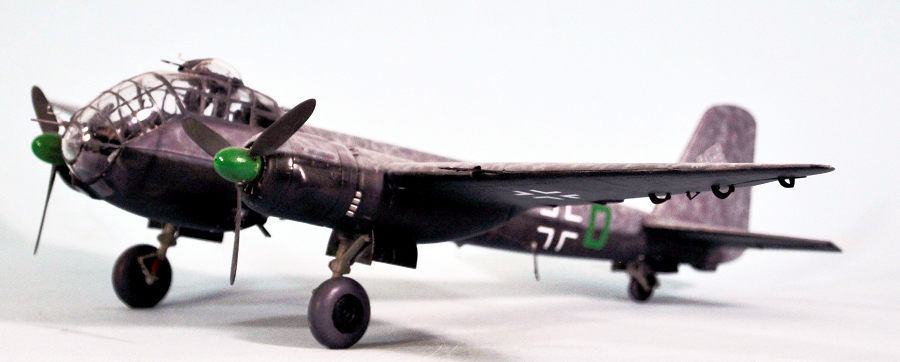
Dragon 1/48 Ju-188E-1
| KIT #: | 5518 |
| PRICE: | $30.00 'used' |
| DECALS: | Two Options |
| REVIEWER: | Tom Cleaver |
| NOTES: |

| HISTORY |
The Junkers Ju 188 was a high-performance medium bomber built during World War II, the planned follow-up to the Ju 88 with better performance and payload. It was produced only in limited numbers, due both to the presence of improved versions of the Ju 88, as well as the increasingly effective Allied strategic bombing campaign against German industry and the resulting focus on fighter production.
The Ju-188 is another example of failure of the German aviation industry to successfully produce and introduce into operations follow-on designs to the original aircraft designs with which the Nazis first went to war. At the time the Ju-88 was introduced to service in 1939, the Reich Luftfartsministerium (RLM) was already in the process of looking for the replacement for the Schnellbomber, which would be a new design that would be faster, fly higher, and have a larger warload. This emerged as the "Bomber B" program, but this was delayed due to the failure of the large 2,470 hp-class engines, like Junkers' Jumo 222. The Ju 288 was leading the contest, but there was no delivery date on the engines.
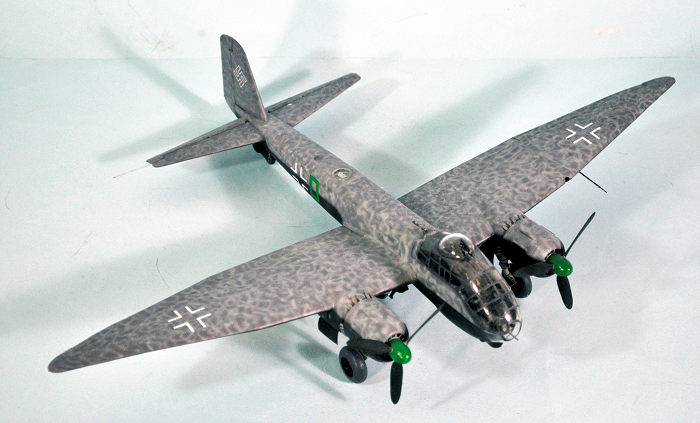 To address the immediate need, the Ju 88B project
was re-submitted as a stop-gap. For this version, they used the latest
short-wing Ju 88 A-1 airframe as a baseline with the Ju 88B's new stepless
cockpit design, with the new Jumo 213 engine, which had recently started
bench testing and was expected to deliver 1,480 hp. The RLM also stipulated
that the aircraft should also be able to accept the BMW 801 radial engine in
a Kraftei (power-egg) unitized
installation, with no modification to the engine nacelles. When the design
finally flew, the RLM was not impressed with it, as it offered only small
improvements over the Ju 88A model in service but suggested that Junkers
continue with the prototype work anyway.
To address the immediate need, the Ju 88B project
was re-submitted as a stop-gap. For this version, they used the latest
short-wing Ju 88 A-1 airframe as a baseline with the Ju 88B's new stepless
cockpit design, with the new Jumo 213 engine, which had recently started
bench testing and was expected to deliver 1,480 hp. The RLM also stipulated
that the aircraft should also be able to accept the BMW 801 radial engine in
a Kraftei (power-egg) unitized
installation, with no modification to the engine nacelles. When the design
finally flew, the RLM was not impressed with it, as it offered only small
improvements over the Ju 88A model in service but suggested that Junkers
continue with the prototype work anyway.
By 1942, it was becoming clear the Ju 288, was not going to be ready soon, while the Ju 88 was increasingly at the mercy of RAF and VVS fighters. The RLM finally decided that the Ju 88B was worth considering even with only the small gains in performance in and asked Junkers for an improved aircraft as the Ju 188.
The sole Ju 88 E-0 was modified with another 13 mm MG 131 firing rearward just below the turret, one firing forward through the nose and twin 7.92 mm MG 81Z machine guns in the integrated ventral gondola firing rearward. It was planned to use the Ju 188 British shipping. A second Ju 188 test airframe was built from another Ju 88 A-4, this one including a larger, more trapezoidal vertical tail surface set to provide more directional control at higher altitudes, a feature also used on future Ju 88 models. Originally known as Ju-88 V44, this airframe was later named Ju-188 V1.
The Ju 188 was chosen for production in October 1942. The RLM then asked for another change, allowing the aircraft to mount either the BMW 801 or Jumo 213 engines as a complete Kraftei or "power egg" common engine installation. Concerns about the Jumo 213, now years overdue, were offset by this engine's better altitude performance. The second Ju 188 prototype was flown in at Rechlin between September and November 1943.
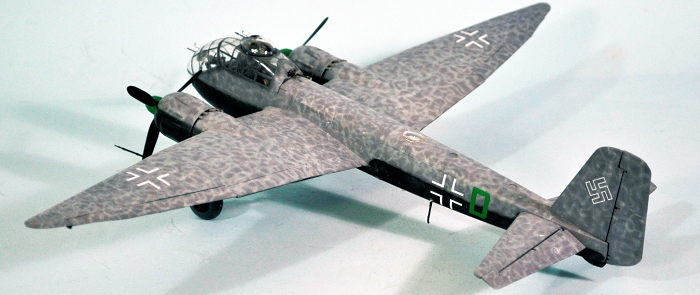 The Ju 188 was designed to be fitted with either the 1,730 hp Jumo
213A or 1,680 hp BMW 801 G-2 engines without any changes to the airframe,
while using similar broad-chord three-blade propellers. It was intended both
would be known as A models but the naming was later changed: the Ju 188A
model powered by the 213 and the Ju 188E by the 801.
The Ju 188 was designed to be fitted with either the 1,730 hp Jumo
213A or 1,680 hp BMW 801 G-2 engines without any changes to the airframe,
while using similar broad-chord three-blade propellers. It was intended both
would be known as A models but the naming was later changed: the Ju 188A
model powered by the 213 and the Ju 188E by the 801.
Delivery problems with the Jumo 213 were never entirely solved and the only model to be built in large numbers were the E series with the BMW 801. Even then, so few were available that they were generally given out to Ju 88 units, who flew them on "special" missions where the longer range or better performance would be helpful. Some 500 Ju 188A and E variants were produced before production ceased in the summer of 1944.
The Ju-188 was perhaps the perfect example of “too little, too late, too poor in performance” to keep the Luftwaffe competitive with its many enemies. The famed German “competence” in technical development failed the country at exactly the right time - for its enemies.
| THE KIT |

The small decal sheet suggests three options: one marking for a KG 6 aircraft, one marking for a reconnaissance unit and one marking for a KG 66 aircraft based in France.
| CONSTRUCTION |
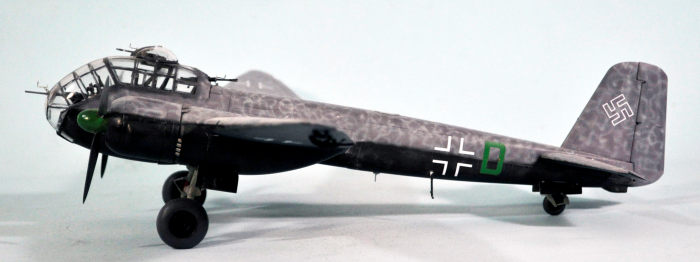 For those interested in bringing a lot of detail to the wide-open
cockpit, there is an Eduard detail set available, which I did not opt for.
For those interested in bringing a lot of detail to the wide-open
cockpit, there is an Eduard detail set available, which I did not opt for.
The kit is designed to be built in modules: fuselage/tail, wings, and cockpit/forward fuselage. These kits are famed for poor fit, but with careful test fitting and modification where necessary, the wings dam together, followed by the fuselage. I only used filler along the centerline of the fuselage and the engine cowlings.
I did use Eduard seat belts for the cockpit, relying for detail on running a white pencil over the raised instrument detail, then brush painting some clear flat over that to fix the pencil.
Many people have commented about the poor fit of the clear canopy to the forward fuselage, which is a bit narrow. I bent the fuselage sides out till they matched, then attached the canopy with cyanoacrylate (after painting it with Future)to get a good fit. With a little fiddling, the forward fuselage fit the rest of the airframe without a problem.
| COLORS & MARKINGS |
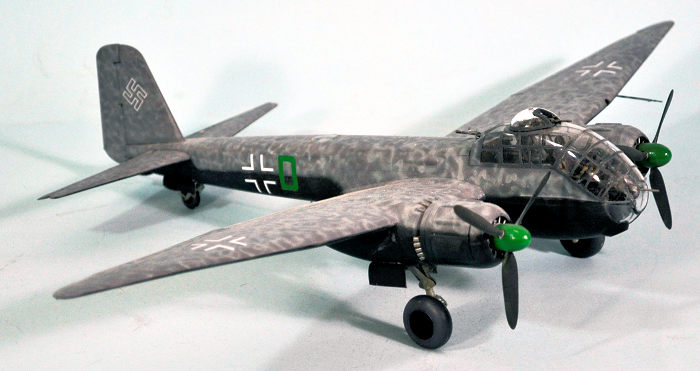 I wanted to do the night time “cloud” camouflage used by airplanes flown
in Operation Steinbok,” the “Little Blitz” in early 1944 that was Hitler’s
“answer” to the massive Allied day and night bombing of Germany. The best thing
that can be said of the operation was that it got a lot of German bombers shot
down that might have been of use after D-Day, for little return in damage to
Britain.
I wanted to do the night time “cloud” camouflage used by airplanes flown
in Operation Steinbok,” the “Little Blitz” in early 1944 that was Hitler’s
“answer” to the massive Allied day and night bombing of Germany. The best thing
that can be said of the operation was that it got a lot of German bombers shot
down that might have been of use after D-Day, for little return in damage to
Britain.
I painted the upper surfaces overall RLM74, then “scribbled” RLM76 over it. One does not have to worry about neatness. I pretended to be two Luftwaffe Feldwebels with sprayguns, told to “paint that thing.” It’s very random overall. When that was finished, I painted the lower surfaces with Tamiya “NATO Black.”
The kit decals are worthless. I was able to find the old Aeromaster Ju-188 sheet at the LHS estate sale, and used that, which was far superior. The result is an airplane of Stab/KG 66, used in Operation Steinbok.
I unmasked the canopy and fitted the guns and upper turret, and glued the lower hatch closed. After attaching the wheels and props, I declared it done.
| CONCLUSIONS |
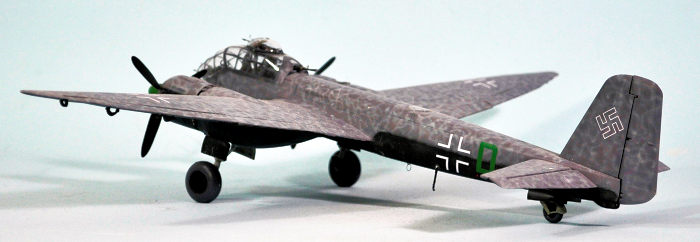 It’s pretty certain no one else will do a Ju-188 (Hello, ICM, forgot
about you), but for now, these kits are what you get. With a little effort, they
look nice. With a little more effort and the Eduard p-e, they can look even
better. The Ju-188 may have come too late to be a war-winner, but it’s a good
looking airplane. Recommended for modelers who have done limited-run kits.
It’s pretty certain no one else will do a Ju-188 (Hello, ICM, forgot
about you), but for now, these kits are what you get. With a little effort, they
look nice. With a little more effort and the Eduard p-e, they can look even
better. The Ju-188 may have come too late to be a war-winner, but it’s a good
looking airplane. Recommended for modelers who have done limited-run kits.
July 2020
Review kit courtesy of my billfold.
Back to the Main Page Back to the Previews Index Page
Back to the Previews Index Page